11 Types of Mammillaria Cactus (With Pictures)
-

- Last updated:
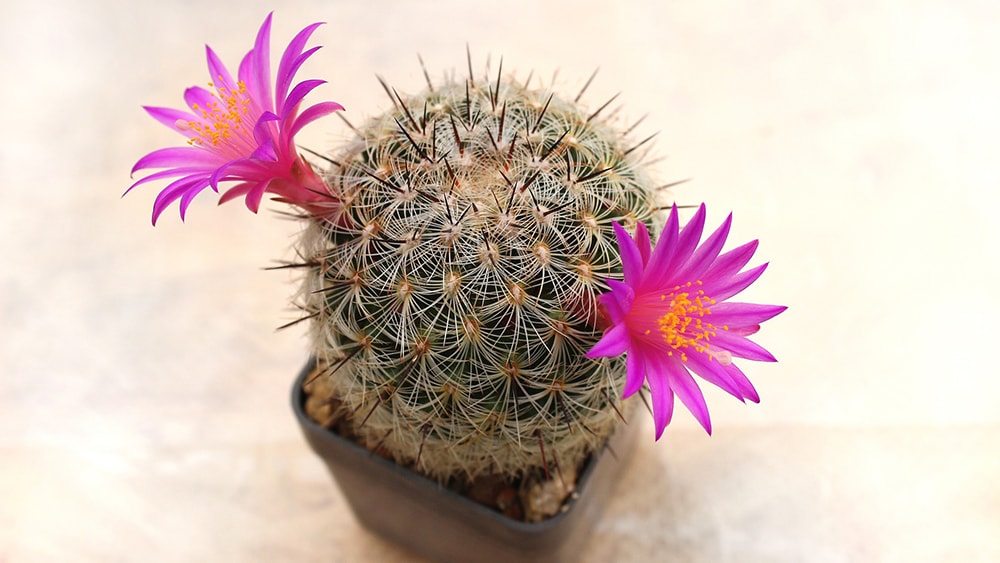
The Mammillaria cacti are arguably the cutest and most charming cacti genus generally characterized by their small, clustered structures. Most varieties of the species are native to Mexico, although some come from the Caribbean, southwest United States, Honduras, Venezuela, Guatemala, and Colombia.
There are over 400 species1 of Mammillaria, and finding the best plant to bring home can be challenging. Fortunately, most species from this cacti family are perfect indoor plants and make eye-catching additions to outdoor flowerbeds.
Read on to learn more about their features, including their appearance, colors, blooming patterns, how tall they grow, and more.

The 11 Types of Mammillaria Cactus
1. Royal Cross (Mammillaria nejapensis)

| Maximum Height: | 4 inches |
| Blooming season: | Spring and summer |
| USDA Hardiness Region: | 6 to 12 |
| Sun Exposure: | Full sun |
Mammillaria nejapensis, commonly referred to as the royal cross or silver arrow, is an exotic flowering cactus native to Oaxaca, Mexico. It has a spherical stem with white hairs between the sharp silver spines. These spines are thicker, longer, and have a copper-red hue at the top.
The royal cross is mainly solitary, although it occasionally branches. Even upon maturity, it hardly grows taller than 4-inches. However, it grows wider and forms a beautiful crown of cream funnel flowers. If you are cultivating the royal cross outdoors and not on your window sill, winterize the plant or bring it indoors during freezing temperatures.
2. Powder Puff Cactus (Mammillaria bocasana)
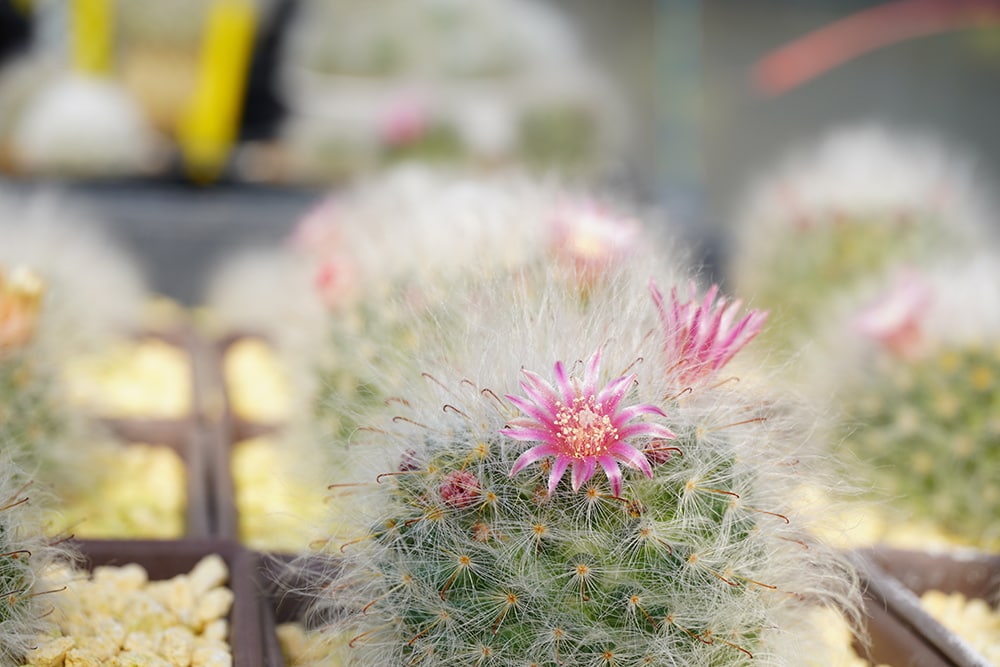
| Maximum Height: | 4 inches |
| Blooming season: | Spring and summer |
| USDA Hardiness Region: | 9 to 11 |
| Sun Exposure: | Full sun/partial shade |
The Mammillaria bocasana, better known as the powder puff cactus, is a native of Northcentral Mexico. It is a small cacti species that grows to a maximum of four inches tall. The plant has a round gray-green stem with a full crown of soft and silky, white hairy spines.
So, how did the Mammillaria bocasana get the nickname powder puff cactus? It is a clump-forming cactus, and the white hair-like radial spines look like cotton balls.
The powder puff cacti produce striking flowers upon maturity. During spring and summer, tiny brilliant white or bright pink blooms appear. Like most cacti varieties, the Mammillaria bocasana thrives in well-draining soil and loves temperatures between 70 and 80 degrees Fahrenheit.
3. Pincushion Cactus (Mammillaria spinosissima)
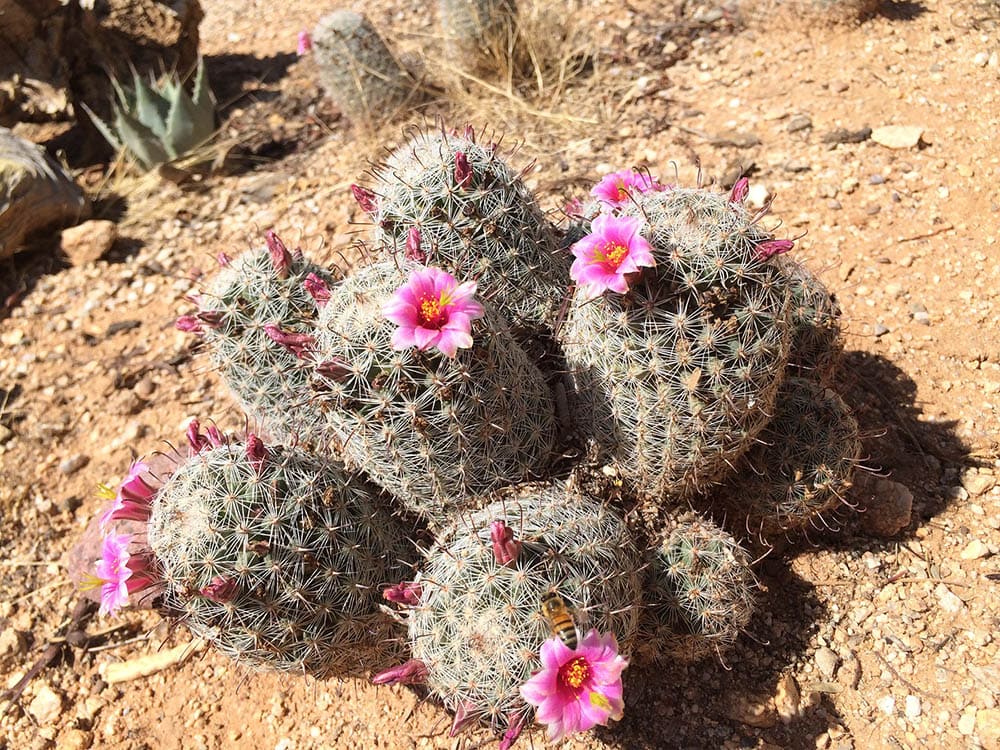
| Maximum Height: | 6 inches |
| Blooming season: | Spring |
| USDA Hardiness Region: | 9a to 10 |
| Sun Exposure: | Full sun |
The pincushion cactus is perhaps the most common Mammillaria cacti species in homes. It is native to the United States and can grow to a maximum height of 6 inches.
Mammillaria spinosissima is commonly known as “pincushion” because of the sharp white spines covering its barrel or ball-shaped stem. It is crucial to wear thick gloves when handling the plant to avoid injury.
Under the proper watering and temperature conditions, even indoor pincushion cacti will form flowers on their tubercles. You can enhance the chances of your cacti blooming by making a fertilizer application in early spring. Also, ensure your plant receives plenty of bright direct light or full sun with some shade in the afternoon to minimize evaporation.
4. Mother of Hundreds (Mammillaria compressa)
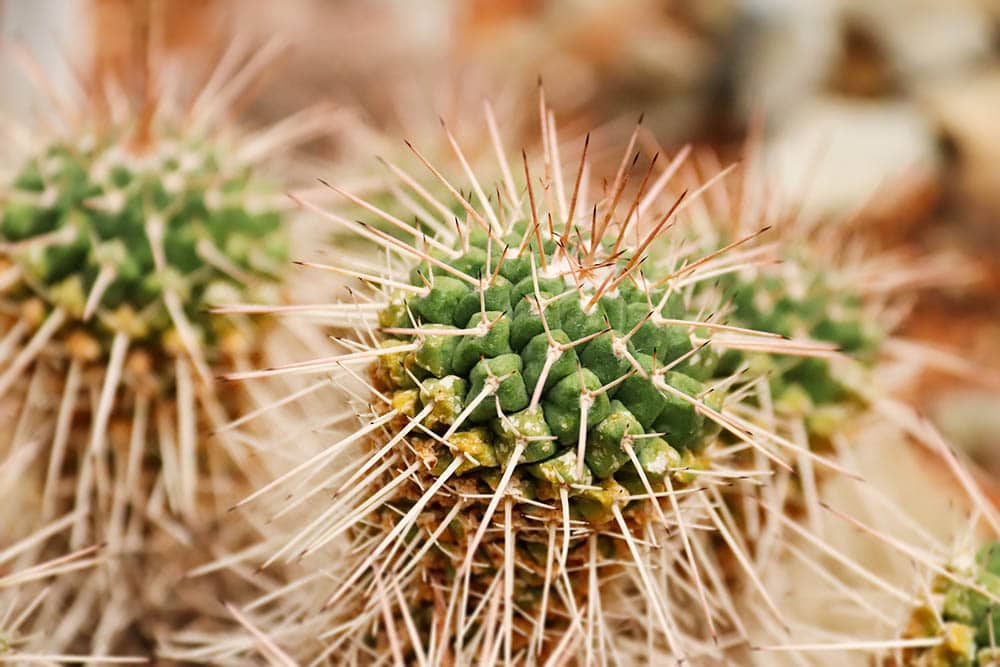
| Maximum Height: | 10 inches |
| Blooming season: | Summer |
| USDA Hardiness Region: | 9a to 10b |
| Sun Exposure: | Full sun |
Mammillaria compressa, commonly referred to as the “Mother of Hundreds” cactus, is one of the larger varieties of the Mammillaria genus. The cactus is native to northern and southern Mexico and is a top choice for most homeowners because it requires minimal care and maintenance to thrive. You can expect your spiky buddy to grow well as long as it receives partial shade to full sunlight.
The Mother of Hundreds forms large, dull, pale green mounds with sparsely distributed white spines. When planted outdoors, the plant can form large clumps of up to 3 feet. In the summer, you can expect the reward of reddish-pink blossoms as long as your cactus gets just enough sunlight, water, and high potassium fertilizer.
5. Woolly Nipple Cactus (Mammillaria mammillaris)
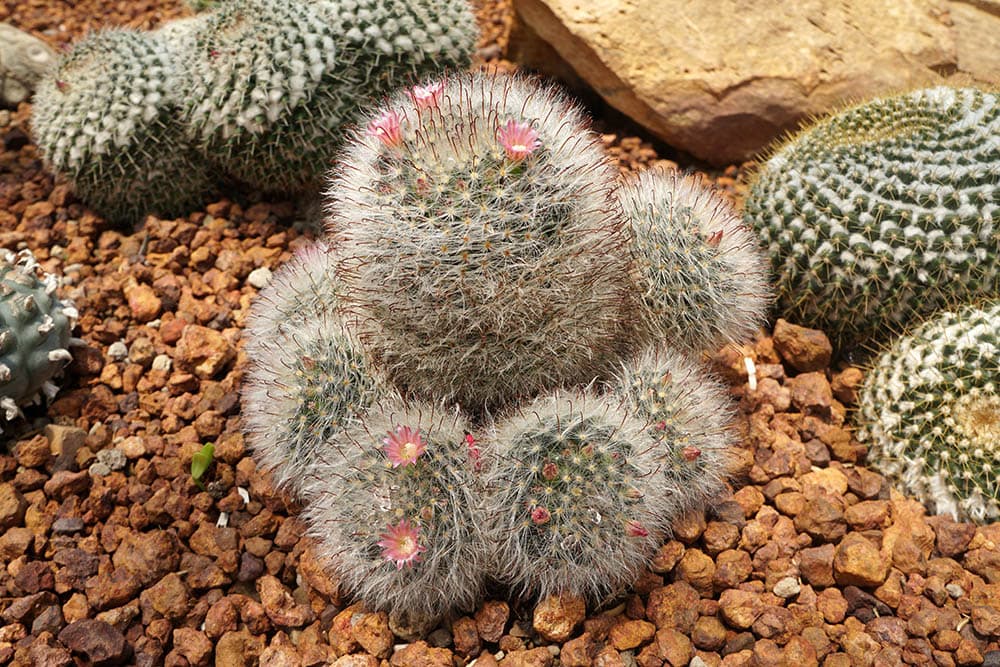
| Maximum Height: | 9 inches |
| Blooming season: | Late summer |
| USDA Hardiness Region: | 10a to 11b |
| Sun Exposure: | Full sun/partial shade |
“Mammilla” in Latin means teat or nipple. On the other hand, the term “aris” refers to the characteristic of the laterally compressed tubercles with wooly areoles. The plant also has wool in the axils between its tubercles. Under the right conditions, it produces creamy-while funnel-shaped blossoms.
Mammillaria mammillaris, a native to the Caribbean, grows as a solitary cactus or in a clump to form a small mat. The plant can reach up to 9 inches in height, and its short cylindrical stem can grow up to 4 inches in diameter. It has relatively long spines that can grow about 1.5 inches long and overlap to protect the delicate parts of the plant.
6. Cushion Foxtail Cactus (Escobaria alversonii)
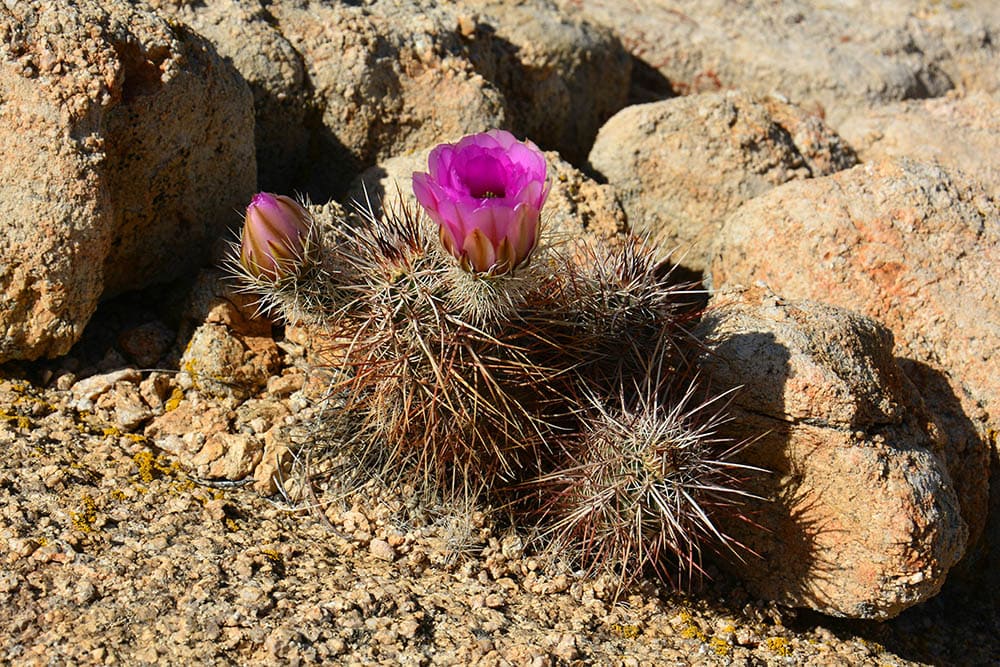
| Maximum Height: | 10 inches |
| Blooming season: | Summer |
| USDA Hardiness Region: | 9b to 11 |
| Sun Exposure: | Full sun |
Escobaria alversonii, better known as cushion foxtail, is one of the rarest cacti species in the Mammillaria genus. It is native to Mexico and the Southwestern United States. The areoles of the cushion foxtail cactus produce up to 33 radial spines that point outwards at all angles.
Upon maturity, the cushion foxtail can grow up to 10 inches tall. If you maintain the right conditions, your cactus will reward you by producing cute pink or violet blossoms in summer. If you are lucky to get your hands on this cactus, make sure you plant it in well-draining soil in a location that receives plenty of sunlight.
7. Lady Fingers (Mammillaria elongata)
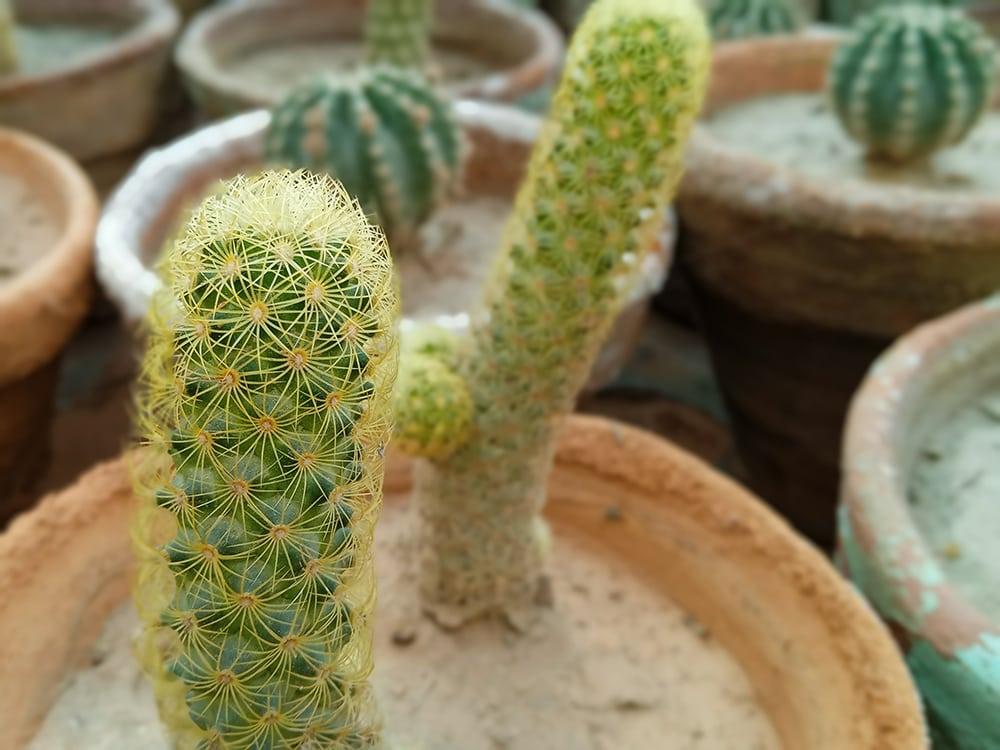
| Maximum Height: | 8 inches |
| Blooming season: | Mid-winter and late spring |
| USDA Hardiness Region: | 9b to 11b |
| Sun Exposure: | Full sun |
Mammillaria elongata, commonly referred to as lady fingers, golden stars, or gold lace cactus, is native to Central Mexico. It is one of the most ornamental species in the Mammillaria genus of flowering cacti. While it has spines that form an alluring brown or white-yellowish mat over the plant, they are harmless.
This lovely cactus has numerous spines covering the cylindrical stems too. It can grow up to 8 inches tall when considering the length of all the long and narrow finger-like stems. In spring, the cactus blooms in understated white to pale yellow colors. Typically, the tiny flowers bud from the upper half of the stems.
You should consider checking your watering routines if your lady fingers cactus does not bloom between mid-winter and late spring. Also, ensure the plant receives plenty of sunlight during the summer because this is when growth is at its peak.
8. Owl’s Eye Pincushion (Mammillaria parkinsonii)
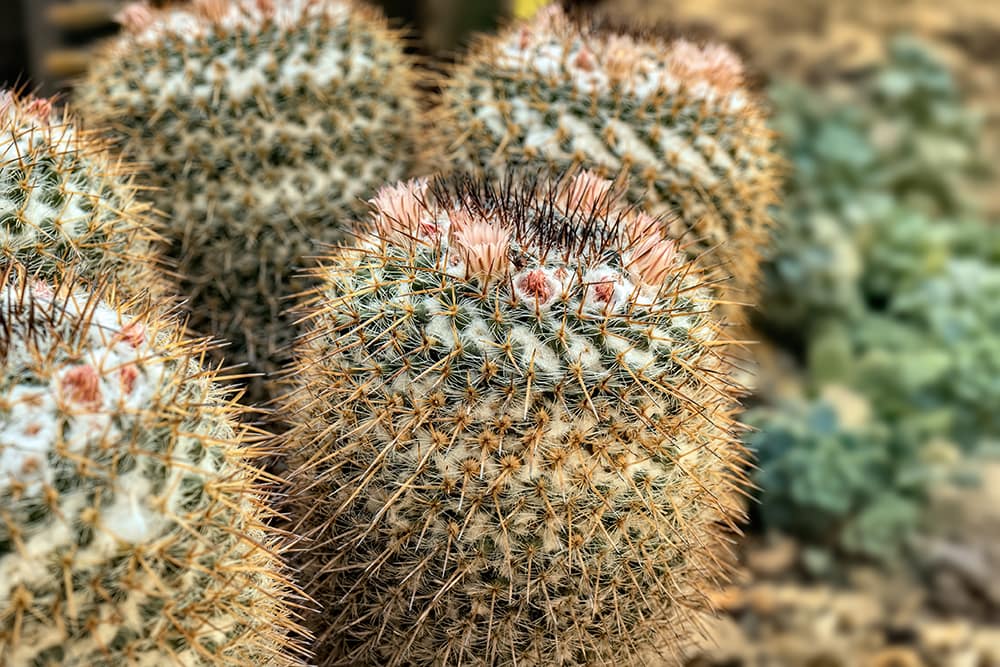
| Maximum Height: | 6 inches |
| Blooming season: | Spring |
| USDA Hardiness Region: | 9b to 11 |
| Sun Exposure: | Full sun |
The Mammillaria parkinsonii, also known as owl’s eye pincushion cactus, is a woolly cactus with a cylindrical stem. The cactus can grow up to 5.9 inches wide and 6 inches tall when solitary. However, the Mammillaria parkinsonii is clump-forming cacti and can develop up to 10 new heads in 5 to 6 years.
With time, the stems divide into two hence the nickname owl’s eye. This charming cactus blossoms in spring and develops funnel-shaped creamy yellow blooms with pink markings. The flowers form in a ring at the top of the stem and later develop into small orange cherry-like fruits.
The owl’s eye pincushion is native to Mexico. This means the plant thrives in dry climates and warm temperatures or semi-desert conditions. For the best outcome, water in moderation and ensure your plant receives bright filtered light.
9. Old Lady Cactus (Mammillaria hahniana)
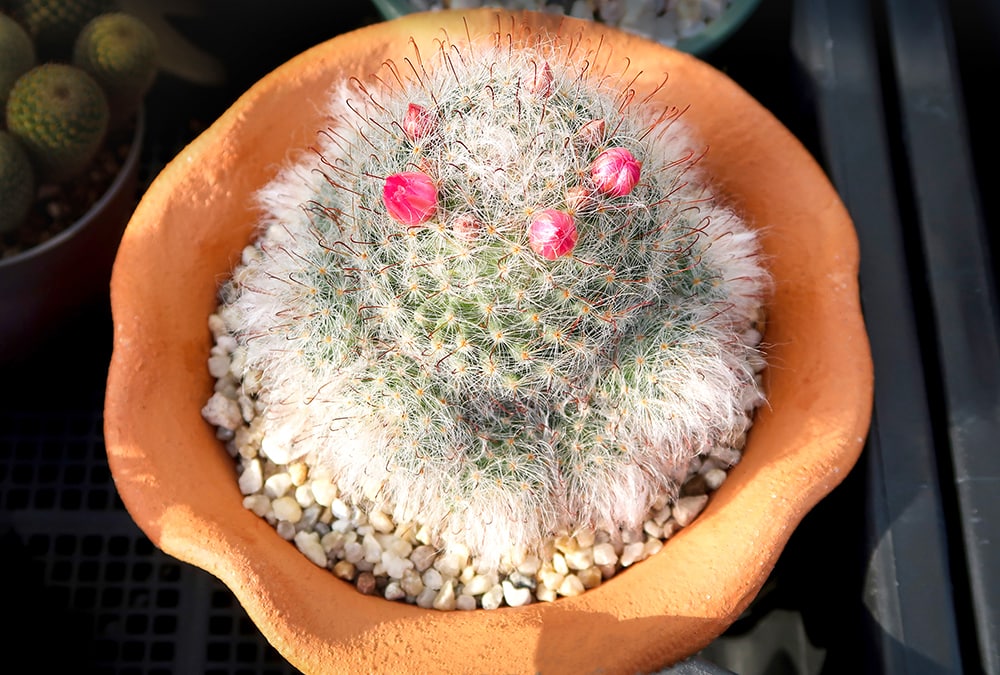
| Maximum Height: | 10 inches |
| Blooming season: | Summer and spring |
| USDA Hardiness Region: | 9a to 10a |
| Sun Exposure: | Full sun/partial shade |
The Mammillaria hahniana is a clump-forming cactus with beautiful spherical stems. It is covered in sharp white spines and silky white down, making it look like an old lady from afar. The plant blooms in summer and spring with a crown of reddish-purple flowers.
Mammillaria hahniana or old lady cactus is native to Mexico. The cactus makes an excellent indoor or outdoor plant. Its spheres can grow up to 5 inches wide and 4 inches tall. Like most cacti, it is a slow-growing plant, and it could reach up to 10 inches tall over several years.
It is imperative to give the cactus proper care through regular watering and fertilizer application routines during summer and spring. Because the plant does dormant in winter, you must not water it to avoid root rot.
10. Pineapple Cactus (Mammillaria longimamma)
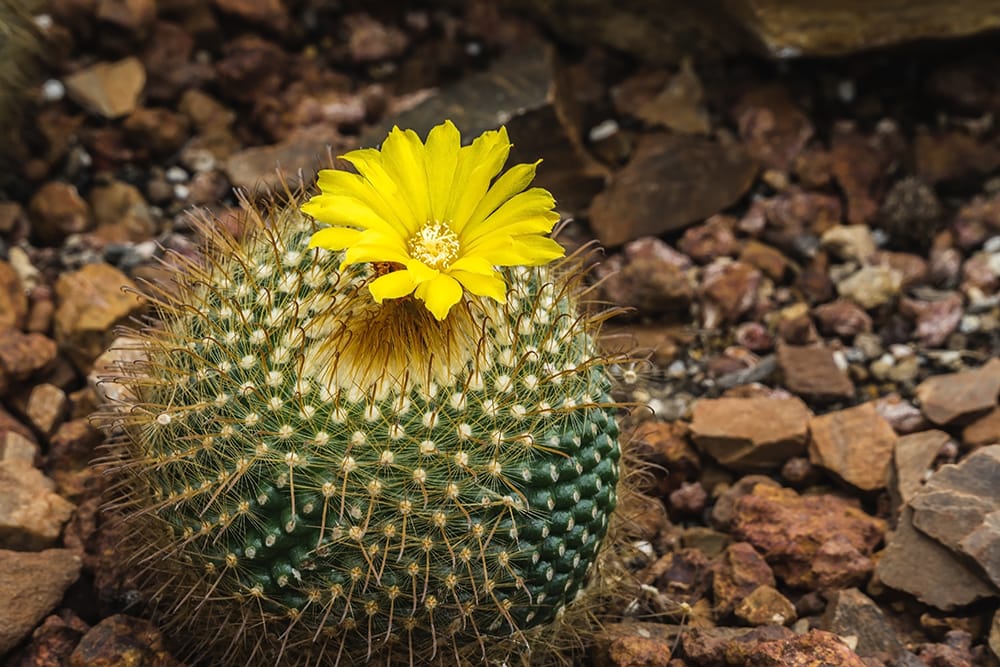
| Maximum Height: | 11.8 inches |
| Blooming season: | Spring |
| USDA Hardiness Region: | 9b to 11b |
| Sun Exposure: | Full sun/partial shade |
Mammillaria longimamma goes by many nicknames, including nipple cactus, finger mound, finger cactus, and pineapple cactus. Its unique physical traits make it pretty easy to identify. Among its distinctive characteristics are the finger-like white spines and soft tubercles.
Also, the Mammillaria longimamma has a larger flower than other cacti varieties of its species. It blooms in spring to produce eye-catching yellow blossoms. Even though the cactus is somewhat frost-hardy, don’t forget to move it indoors during winter.
11. Fishhook Cactus (Mammillaria grahamii)
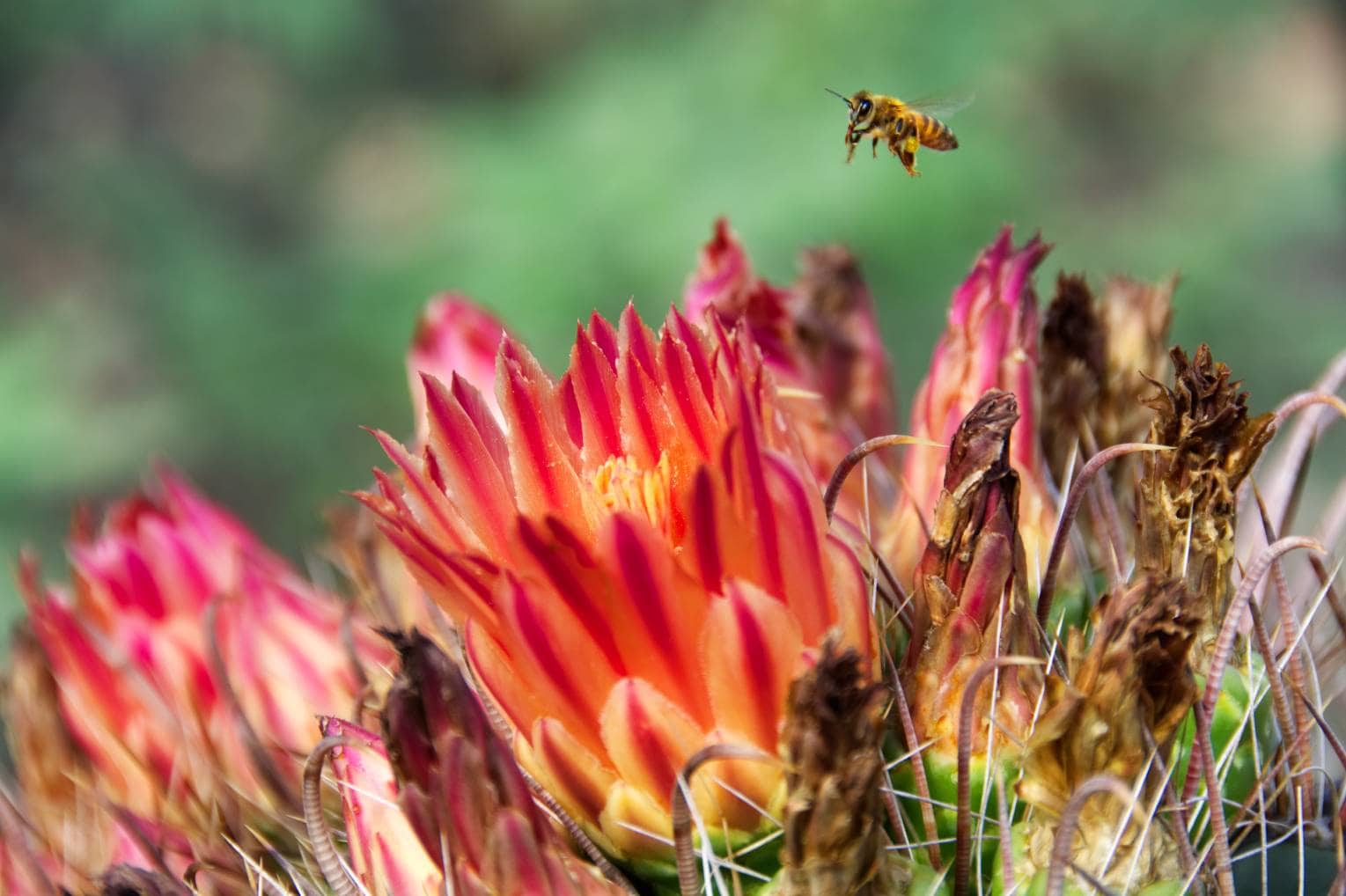
Mammillaria grahamii, commonly referred to as fishhook or Graham’s nipple cactus, is native to Texas, Arizona, California, and Mexico. You can also spot large clumps of the Mammillaria grahamii in the Sonoran Desert on the U.S. Mexico border.
Some of the unique traits of the cactus include a cylindrical stem that can grow up to 2.5 inches in diameter and 6 inches tall. If the plant gets at least 4 hours of direct sunlight daily and water whenever the soil dries up, you can expect the pleasant reward of pink or lavender flowers in summer.
 Frequently Asked Questions
Frequently Asked Questions
Mammillaria cacti varieties are highly sought after for their beauty and because they are low maintenance. Here are some commonly asked questions about these plants.
How Do I Ensure My Mammillaria Cacti Thrive?
Mammillaria cacti, irrespective of species, are pretty forgiving, even if you have busy work schedules. The plants don’t require much watering but make sure to expose them to enough sunlight.
When Is the Best Time to Fertilize My Mammillaria Cacti?
Fertilizer application is crucial, especially during the initial germination and growing processes. Use a well-balanced water-soluble fertilizer with “10-10-10” nitrogen, phosphorus, and potassium. You can make fertilizer applications in summer and spring, although the plant does not need fertilizing in winter when it becomes dormant.
Which Is the Best Container Size for My Mammillaria Cactus?
Choosing a container size for a Mammillaria cactus can be tricky, and it is crucial first to understand whether your plant grows solitary or in a group. Generally, it is best to ensure you will not need repotting for the next few years. If the cactus is a clump-forming variety, wait until the seedlings are strong enough before you transfer them to a new pot.

Final Thoughts
Mammillaria cacti have interesting nicknames and breathtaking looks. They are low-maintenance plants and only need watering when the potting soil dries up. You can also add some fertilizer, especially during the spring and summer when growth is at its peak. Thanks to their drought tolerance, they typically don’t hold grudges if you forget to water them for several weeks.
Meeting the environmental needs of any cacti from the Mammillaria genus is easy; you simply need to use a fast-draining potting mix and a planter with good drainage. Most species make excellent desk buddies, or you can let your Mammillaria cactus sit on your windowsill to brighten up your interiors.
- See Also: 5 Types of Lawn Mower Blades
Featured Image Credit: elektrosmart, Pixabay
Contents
 Frequently Asked Questions
Frequently Asked Questions